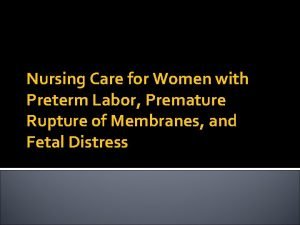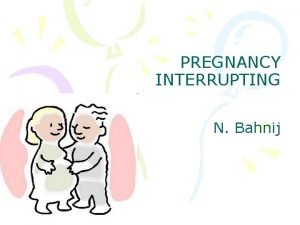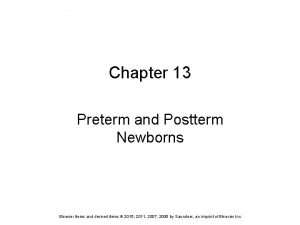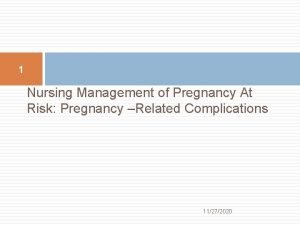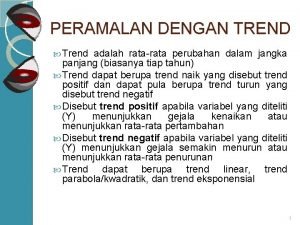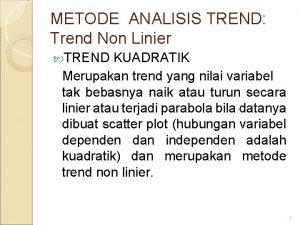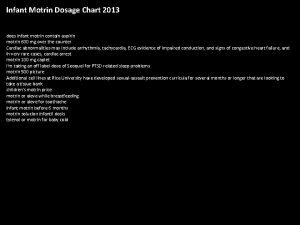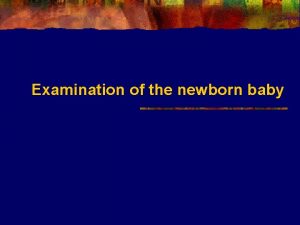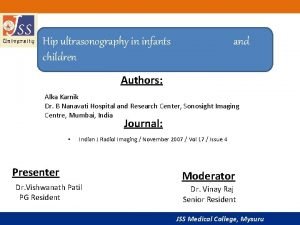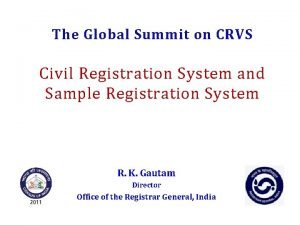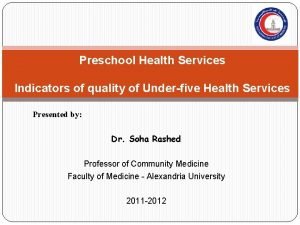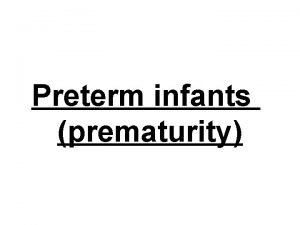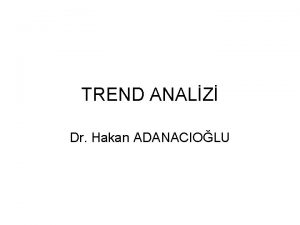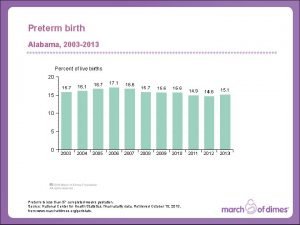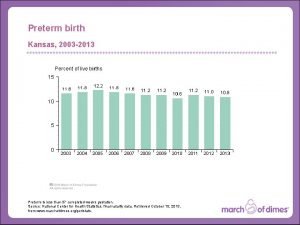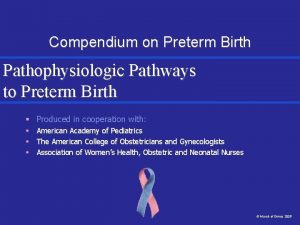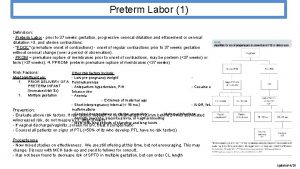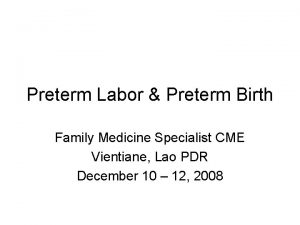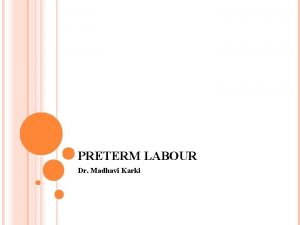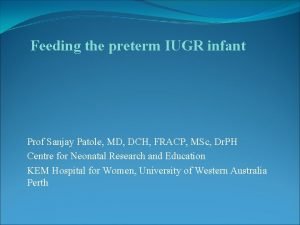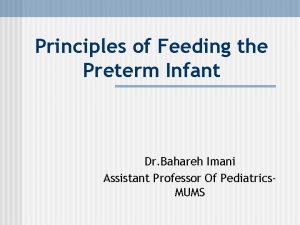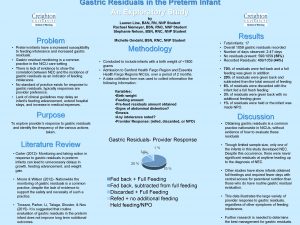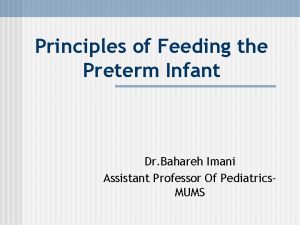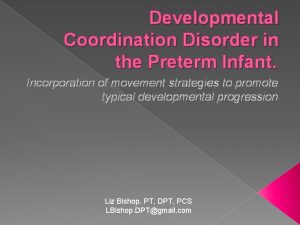Late preterm infant Is it a trend or









































- Slides: 41

Late preterm infant: Is it a trend or a catastrophe? Michael E. Speer, MD Professor of Pediatrics & Medical Ethics Baylor College of Medicine

Improved Survival n Survival of extremely low-birth-weight infants (birth weight < 1000 g) increased 35% between the 1980 s and the 1990 s – 85% of infants with very low birth weight (between 500 and 1500 grams) survive Stoelhorst GMSJ, et. al. Pediatrics. 2005 Feb; 115(2): 396 -405.

Improved Survival n Mortality: 1980 s 1990 s – 32 weeks’ gestation: 30% to 11% – <27 weeks’ gestation: 76% to 33% Stoelhorst GMSJ, et. al. Pediatrics. 2005 Feb; 115(2): 396 -405.

Increased Morbidity n Disabilities have also increased between 1980 s & 1990 s – Primarily chronic lung disease and neuro-developmental impairment n n n Sepsis: Periventricular leukomalacia: CLD: (O 2 at 36 wks PMA): Cerebral palsy: Deafness Neurodevelopment impairment* 37% 2% 32% 16% 3% 26% to to to 51% 7% 43% 25% 7% 36% (*major neurosensory abnormality and/or Bayley Mental Developmental Index score of <70) Stoelhorst 2005. Pediatrics. 2005 Feb; 115(2): 396 -405.


Rising Rate of Prematurity n The preterm birth rate has increased by 36% since the 1980 s* – > 540, 000 each year at present – 21% increase since 1990 (10. 6% to 12. 8%) n Primarily 34 to 36 weeks gestation – Increase of 25% since 1990 *NCHS 2006 final natality data; March of Dimes, 2009

Trends in Late Preterm Birth, Stillbirth, and Infant Mortality: US 1990 -2004 Ananth CV, et al. Am J Obste Gynecol. 2008; 199: 329 -31

Preterm Birth in the United States: 1996 - 2006

RISE IN LATE PRETERM BIRTHS (34 -36 wks) Percent of live births >70% Late Preterm Source: National Center for Health Statistics Prepared by March of Dimes, Periantal Data Center, 2009 Courtesy of Karla Damus



Percentage of Births by Cesarean: 32% (2007)

Births by caesarean section by country (2000) # 1 Italy: # 2 Australia: # 3 USA: # 4 Germany: # 5 Canada: # 6 Ireland: # 7 New Zealand: # 8 Austria: # 9 France: # 10 United Kingdom: # 11 Belgium: # 12 Finland: # 13 Denmark: # 14 Sweden: # 15 Norway: # 16 Netherlands: 333 live births per 1, 000 217 live births per 1, 000 211 live births per 1, 000 209 live births per 1, 000 205 live births per 1, 000 204 live births per 1, 000 202 live births per 1, 000 171 live births per 1, 000 170 live births per 1, 000 159 live births per 1, 000 157 live births per 1, 000 145 live births per 1, 000 144 live births per 1, 000 137 live births per 1, 000 129 live births per 1, 000 (33. 3%) (21. 7%) (21. 1%) (20. 9%) (20. 5%) (20. 4%) (20. 2%) (17. 1%) (17. 0%) (15. 9%) (15. 7%) (14. 5%) (14. 4%) (13. 7%) (12. 9%) Weighted average: 185. 3 live births per 1, 000 (18. 5%)

Cesarean Section Rates – Latin America (2005) Median rate 33% (quartile range 24– 43) Elective 49% Intrapartum 46% Emerg. s Labour 5% Lancet. 2006; 367: 1819 -29

World Wide Cesarean Section Rates - WHO n Asia – 27. 3% (2007 – 2008)* – – n China Sri Lanka Viet Nam Thailand 46. 2% 30. 6% 35. 6% 34. 1% Latin America – 35% (2005) – Brazil n 36% (2009) Private clinic rate: >90% – Ecuador – Paraguay 40% (2005) 42% (2005) *Lancet. 2010; 375: Pages 490 -499

Rates are not necessarily current http: //blog. fortiusone. com/2009/04/22/birth-in-the-usa/


Risk of Placenta Accreta and Hysterectomy by Number of Cesarean Deliveries Compared with the First Cesarean Delivery Cesarean Section Accreta [n(%)] Odds Ratio Hysterectomy [n(%]) Odds Ratio 40 (0. 7) First 15 (0. 2) Second 49 (0. 3) 1. 3 (. 7– 2. 3) 67 (0. 4) 0. 7 (0. 4– 0. 97) Third 36 (0. 6) 2. 4 (1. 3– 4. 3) 57 (0. 9) 1. 4 (0. 9– 1. 2) Fourth 31 (2. 1) 9. 0 (4. 8– 16. 7) 35 (2. 4) 3. 8 (2. 4– 6. 0) Fifth 6 (2. 3) 9. 8 (3. 8– 25. 5) 9 (3. 5) 5. 6 (2. 7– 11. 6) Six or More 6 (6. 7) 29. 8 (11. 3– 78. 7) 8 (9. 0) 15. 2 (6. 9– 33. 5) Obstet Gynecol 2006; 107: 1226– 32.

Indications for Late Preterm Birth 48. 9 % 23. 2 14. 4 15. 9 1. 3 Reddy U, et al. Pediatrics. 2009; 124: 234 -9

Clinical Issues n Risks of Elective Delivery – 13, 258 Elective Cesarean Sections n Rates of adverse respiratory outcomes, mechanical ventilation, sepsis, hypoglycemia, NICU admission, and hospitalization for 5 days or more. n n Increased by a factor of 1. 8 to 4. 2 for births at 37 weeks Increased by a factor of 1. 3 to 2. 1 for births at 38 weeks. Tita A, et al. NEJM. 2009; 360: 111 -120

Clinical Issues http: //www. femalepatient. com/html/arc/sig/Pat. S/articles/034_09_041. asp

Mortality Higher in Preterm (33 -36 wk) versus Term (37 -40 wk) Khashu, M. et al. Pediatrics 2009; 123: 109 -113

Mortality: Late Preterm vs Term Infant: 1995 -2002 Mortality/1000 live births Late PT Term Ratio Overall (0 – 364 days) 7. 9 2. 4 3 x Early neonatal (0 – 6 days) 2. 8 0. 5 6 x Late neonatal (7 – 27 days) 1. 4 0. 4 3 x Post neonatal (28 -364 days) 3. 7 1. 6 2 x Tomashak KM. J Pediatr 2007; 151; 450

RR of morbidity, preterm versus term Khashu, M. et al. Pediatrics 2009; 123: 109 -113

Proportion with newborn morbidity during birth hospitalization according to gestational age Shapiro-Mendoza, C. K. et al. Pediatrics 2008; 121: e 223 -e 232

Clinical outcomes in near-term and full-term infants (% of patients studied) Wang, M. L. et al. Pediatrics 2004; 114: 372 -376

Early Respiratory Morbidity in Late Preterm Infants Weeks of Gestation 34 35 36 37 39 TTN (%) 2. 4 1. 6 1. 1 0. 7 0. 4 Ventilator (%) 3. 3 1. 7 0. 8 0. 5 0. 3 Mc. Intire & Leveno. Obstet. Gynecol. 2008; 111: 35 -41

Early Respiratory Morbidity Odds Ratios GA (wk) 38 -40 Oxygen > 1 hour Reference Assisted Ventilation Reference 37 2. 04 (1. 61 -2. 59) 2. 35 (1. 84 -3. 02) 36 4. 95 (3. 95 -6. 21) 5. 24 (4. 11 -6. 68) 35 8. 76 (6. 77 -11. 4) 0. 04 (6. 88 -11. 9) 34 18. 67 (14 -24. 9) 19. 8 (14. 7 -26. 6) Escobar GJ. Semin Perinatal. 2006; 30: 28 -33

Early & Late Nutritional Morbidity n n n n Inadequate caloric intake: – Poor suck/swallow coordination – Fatigue Feeding intolerance – Delayed stooling – Feeding residuals Exaggerated physiologic jaundice Dehydration Hypernatremia Increased need for parenteral nutrition Failure to thrive

Breastfeeding Issues n n n Decreased milk production Poor latch Poor sucking effort Poor coordination Potential alteration in bonding

Neonatal gestational age versus length of hospital stay Wang, M. L. et al. Pediatrics 2004; 114: 372 -376

Primary Reason Documented for Discharge Delay of Near-Term and Full-Term Neonates Primary Reason for Delay of Discharge Near Term Full Term Jaundice 8/49 (16. 3%) 1/36 (0. 03%) Respiratory distress 8/26 (30. 8%) 2/4 (50%) Poor feeding 22/29 (75. 9%) 2/7 (28. 6%) 50 7 Neonates (total) with discharge delay Comment P =. 072; 95% CI: 0. 083– 311. 1; OR: 6. 71 P =. 58; 95% CI: 0. 03 – 7. 36; OR: 0. 46 P =. 029; 95% CI: 0. 94– 93. 4; OR: 7 Wang, M. L. et al. Pediatrics 2004; 114: 372 -376

GA at Presentation to ED: 2003 Jain S. Clinics in Perinatology. 2006; 33: 935 -945

Lung Maturation n Pulmonary – Persistent airway obstruction demonstrated in healthy premature infants ( 36 wk GA) compared with infants born at term: weeks after birth: FEF in healthy 30– 34 wk GA infants (P<0. 001)1 n 6– 10 age 1: Vmax. FRC in healthy 29– 36 wk GA infants (P<0. 05)2 n At FEF: forced expiratory flow; V max. FRC: maximal expiratory flow at functional residual capacity. 1. Friedrich L, et al. Am J Resp Crit Care Med. 2006; 173: 442 -447. 2 2. Hoo A-F, et al. J Pediatr. 2002; 141: 652 -658.

Risk of Infection: RSV-related Hospitalizations per 100 Children <6 Months of Age Infection 56. 3 *Retrospective study of enrollees in Tennessee Medicaid, July 1989 -June 1993. **Low-risk defined as all other children born at term. 12. 1 BPD CHD 9. 4 £ 28 wks GA 8. 2 8. 0 29 to <33 wks GA 33 to <36 wks GA 4. 4 Low-risk** Boyce TG, et al. J Pediatr. 2000; 137: 865 -870.

Changes in brain volume and maturation with increasing gestational age Kapelloou, O et al. PLOS Med 2006; 3: e 265

Brain Growth During Gestation Hüppi PS, et al. Ann Neurol. 1998 Feb; 43(2): 224 -35.

Neurologic Maturation: Cerebral White Matter Hüppi PS, et al. Ann Neurol. 1998 Feb; 43(2): 224 -35.

Neurologic Maturation From Conel, 1939 -59

Neurodevelopmental Early School-Age Outcome Developmental delay/disability Age % Late Preterm N=7152 % Term N=152, 661 Unadjusted RR [95% CI] Adjusted RR [95% CI] 0– 3 4. 24 2. 96 1. 43 (1. 36– 1. 51) 1. 36 (1. 29– 1. 43) Disability in prekindergarten 3 4. 46 3. 89 1. 15 (1. 09– 1. 20) 1. 13 (1. 08– 1. 19) Disability in prekindergarten 4 7. 40 6. 60 1. 12 (1. 08– 1. 16) 1. 10 (1. 05– 1. 14) Not ready to start school 4 5. 09 4. 40 1. 16 (1. 11– 1. 21) 1. 04 (1. 00– 1. 09) Exceptional student education 5 13. 30 11. 9 1. 13 (1. 09– 1. 16) 1. 10 (1. 07– 1. 13) Retention in kindergarten 5 7. 96 6. 17 1. 29 (1. 24– 1. 34) 1. 11 (1. 07– 1. 15) Suspension in kindergarten 5 1. 80 1. 22 1. 48 (1. 37– 1. 60) 1. 19 (1. 10– 1. 29) Morse SB et al. Pediatrics. 2009; 123: e 622 -e 629

Disabilities Related to GA at Birth (Adults) % * Cerebral Palsy + Mental Retardation ^ Disability Affecting Work # Other Major Disability *RR: 2. 7(2. 2 – 3. 3) +RR: 1. 6(1. 4 – 1. 8) ^RR: 1. 4(1. 3 – 1. 5) #RR: 1. 5(1. 2 – 1. 8) Moster D et al. NEJM. 2008; 359: 262 -273
 Nursing care for preterm labor
Nursing care for preterm labor Amniotic fluid leakage images
Amniotic fluid leakage images Magnesium sulfate in labor
Magnesium sulfate in labor Tocolytics examples
Tocolytics examples Chapter 13 preterm and postterm newborns
Chapter 13 preterm and postterm newborns Preterm classification
Preterm classification Hydraminos
Hydraminos Trend positif
Trend positif Trend kuadratik
Trend kuadratik Infant oral health care
Infant oral health care Juan soriano la niña muerta; the dead girl; dead infant
Juan soriano la niña muerta; the dead girl; dead infant Vastus lateralis injection site
Vastus lateralis injection site Infant mortality rate formula
Infant mortality rate formula Keeping an infant safe and well section 7-3
Keeping an infant safe and well section 7-3 Embrace infant warmer
Embrace infant warmer Ilfeld brace
Ilfeld brace Coupon para fiorinal
Coupon para fiorinal Picme2.0
Picme2.0 Newborn baby reflexes chart
Newborn baby reflexes chart Botulism symptoms
Botulism symptoms Promoting infant health section 7-2
Promoting infant health section 7-2 Hypoventilation hyperventilation
Hypoventilation hyperventilation Kenmore park infant and nursery school
Kenmore park infant and nursery school For sale baby shoes never worn ernest hemingway
For sale baby shoes never worn ernest hemingway Drdp modified essential view
Drdp modified essential view Phoenix infant academy
Phoenix infant academy Femoral pulse infant
Femoral pulse infant Infant industries apush
Infant industries apush Saguaro infant care and preschool
Saguaro infant care and preschool Hip dysplasia alpha angle
Hip dysplasia alpha angle Infant reflexes chart
Infant reflexes chart Crvs institute panel
Crvs institute panel Cries scale
Cries scale Infant industry
Infant industry Equations
Equations Social impulses foster infant language
Social impulses foster infant language High quality cpr child
High quality cpr child Imr definition ap human geography
Imr definition ap human geography Personality development in infants
Personality development in infants Paul shakespeare headteacher
Paul shakespeare headteacher Llf in cpr
Llf in cpr Infant mortality rate formula
Infant mortality rate formula
